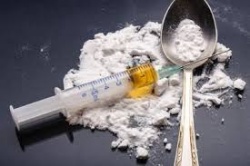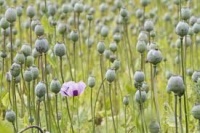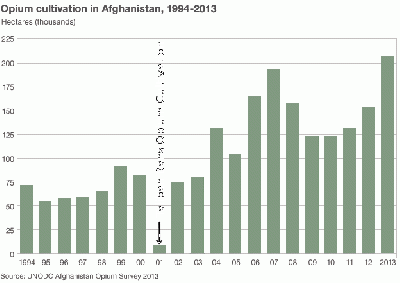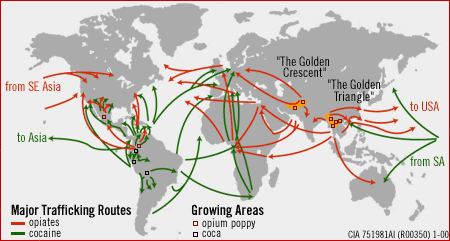Difference between revisions of "Heroin"
m (Text replacement - "|WP=https://" to "|wikipedia=https://") |
m (Text replacement - "1950s " to "1950s ") |
||
| Line 16: | Line 16: | ||
==Production== | ==Production== | ||
[[image:Opium production in Afghanistan.gif|400px|right]] | [[image:Opium production in Afghanistan.gif|400px|right]] | ||
| − | [[Afghanistan]] was previously ill suited to heroin cultivation, but after US-funded dams were built in the 1950s and 1960s, a rise in the water table in large areas of the country meant it became well suited.<ref>Bitter lake, [[Adam Curtis]]</ref> Nevertheless, after the Taliban prohibited its cultivation, production for one year was very low. After the US lead [[Afghanistan war 2001|invasion]], production has rocketed to record levels. | + | [[Afghanistan]] was previously ill suited to heroin cultivation, but after US-funded dams were built in the [[1950s]] and 1960s, a rise in the water table in large areas of the country meant it became well suited.<ref>Bitter lake, [[Adam Curtis]]</ref> Nevertheless, after the Taliban prohibited its cultivation, production for one year was very low. After the US lead [[Afghanistan war 2001|invasion]], production has rocketed to record levels. |
In 2012 [[Afghanistan]] produced 95% of the world's opium.<ref name="NYT27.10.2014">{{cite web | url=http://www.nytimes.com/2014/10/27/opinion/afghanistans-unending-addiction.html | title=Afghanistan’s Unending Addiction | publisher=[[The New York Times]] | work=Newspaper | date=26 October 2014 | accessdate=28 May 2016 | author=Editorial Board}}</ref> | In 2012 [[Afghanistan]] produced 95% of the world's opium.<ref name="NYT27.10.2014">{{cite web | url=http://www.nytimes.com/2014/10/27/opinion/afghanistans-unending-addiction.html | title=Afghanistan’s Unending Addiction | publisher=[[The New York Times]] | work=Newspaper | date=26 October 2014 | accessdate=28 May 2016 | author=Editorial Board}}</ref> | ||
Revision as of 05:24, 16 September 2016
(drug) | |
|---|---|
 | |
| Interest of | Jardine Matheson |
| An important component of the illegal drug trade. A pain killing drug which is popular with recreational drug users. | |
Heroin (or diamorphine) is a pain killing drug used recreationally. It is used by millions of people annually.
Contents
History
The drug was first made in 1874. It is produced by refinement of opium, the collected dried sap of opium poppies.
Legal status
It is generally illegal to manufacture, possess, or sell heroin without a license. Internationally, heroin is controlled under Schedules I and IV of the Single Convention on Narcotic Drugs.[1]
Production
Afghanistan was previously ill suited to heroin cultivation, but after US-funded dams were built in the 1950s and 1960s, a rise in the water table in large areas of the country meant it became well suited.[2] Nevertheless, after the Taliban prohibited its cultivation, production for one year was very low. After the US lead invasion, production has rocketed to record levels.
In 2012 Afghanistan produced 95% of the world's opium.[3]
Trafficking
The first step is generally the trafficking of raw opium, which Sibel Edmonds has stated is flown by military cargo plane to Turkey for refinement before it is shipped for sale to Europe or North America.
CIA Involvement
After WWII, the ONI and OSS-CIA partnered with the mob in Corsica, Marseilles and other strategic shipping locales, using organized crime to corrupt and undermine labor unions. This, in turn, led to the "French Connection", which flooded the US with heroin.
The Vietnam War is widely cited as an event in which CIA drug trafficking techniques were refined.
In 2014, a surprise drug bust of 35kg of heroin revealed that some was flown to Australia from USA via the Phillipines in a CIA-owned plane. Daniel Hopsicker has noted that this could be explained by high prices for heroin in Australia.[4]
Related Quotation
| Page | Quote | Author |
|---|---|---|
| Drug smuggling | “I stood at the Friendship Bridge at Termez [Uzbekistan] in 2003 and watched the Jeeps with blacked-out windows bringing the heroin through from Afghanistan, en route to Europe. I watched the tankers of chemicals roaring into Afghanistan. Yet I could not persuade my country to do anything about it.” | Craig Murray |
Related Document
| Title | Type | Publication date | Author(s) | Description |
|---|---|---|---|---|
| File:Cannabis comparative risk assessment.pdf | Report | 30 January 2015 | Jürgen Rehm Dirk Lachenmeier | Comparative risk assessment of alcohol, tobacco, cannabis and other illicit drugs using the margin of exposure approach |
References
- ↑ "Yellow List: List of Narcotic Drugs Under International Control" (PDF). International Narcotics Control Board. December 2004. Archived from the original (PDF) on 10 May 2012. Retrieved 5 May 2006.Page Module:Citation/CS1/styles.css must have content model "Sanitized CSS" for TemplateStyles (current model is "Scribunto"). Referring URL = http://www.incb.org/incb/yellow_list.html
- ↑ Bitter lake, Adam Curtis
- ↑ Editorial Board (26 October 2014). "Afghanistan's Unending Addiction". Newspaper. The New York Times. Retrieved 28 May 2016.Page Module:Citation/CS1/styles.css must have content model "Sanitized CSS" for TemplateStyles (current model is "Scribunto").
- ↑ http://www.madcowprod.com/2014/09/12/mystery-aircraft-busted-in-australia-was-cia-plane/


